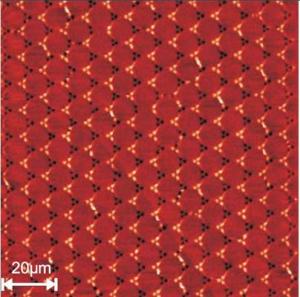Aug 5 2010
Spin ice can be used to examine exotic properties of magnetic systems. Surprising observations have been made by physicists working with Prof. Dr. Hartmut Zabel at the Ruhr-Universität, using magnetic islands only micrometres in size that are placed on a periodic lattice with honeycomb symmetry.
When a magnetic field is applied, the system selects an unexpectedly ordered state, hazarding the consequences of having the like poles of the magnets (all south or all north) close together which is energetically unfavourable. "A better understanding and control of such magnetic monopoles in the honeycomb lattice will permit storage of far more information in these states than is the case when using conventional storage techniques that know only two states", is how Prof. Zabel explains the significance of the experiment. A report by the researchers is featured in the current issue of the "Applied Physics Letters".
 The illustration with a magnetic force microscope shows the arrangement of magnetic north poles (pale points) and south poles (dark points) on a lithographic honeycomb lattice.
The illustration with a magnetic force microscope shows the arrangement of magnetic north poles (pale points) and south poles (dark points) on a lithographic honeycomb lattice.
Spin ice materials have a lot in common with water ice that has an extremely complex structure. Even when approaching absolutely zero temperature, water is still in a disordered state. This comes from the fact that in ice, one oxygen atom is surrounded by four hydrogen atoms that mark the corners of a tetrahedron. Two hydrogen atoms belong to the original H2O water molecule and the other two to the neighbouring water molecule. The so-called ice rule says that the two original hydrogen atoms take up a position close to the oxygen atom, while the other two are further away: "two in, two out". However, in reality there are always faults in this order.
Magnetic ice
Spin ice is the magnetic equivalent of ice. Here four magnetic dipoles – atoms with a north and south pole – sit at the corners of a tetrahedron in a crystal lattice. On heeding the ice rule – two north poles look out, two in – then their magnetic forces are balanced with a favourable energetic state. But if one dipole is "turned round", this creates a magnetic monopole. "Free magnetic monopoles don't exist in nature. But spin ice materials give us the possibility of examining the exotic properties of magnetic monopoles and verifying theories about their interaction", explains Prof. Zabel. To this end, the researchers create artificial spin ice lattices using lithographic methods. Magnetic islands only micrometres in size are arranged in the plane so that three or four of their ends meet in one node in each case. Four dipoles produce so-called square spin ice; three dipoles result in triangular spin ice, also referred to as the "honeycomb structure". The honeycomb structure obeys a modified ice rule: one north or south pole looks out, two in: in energetic terms the best possibility, even though it is not completely magnetically balanced.
Tiny magnetic honeycomb islands
The RUB researchers carved magnetic dipole islands out of an iron layer using electron beam lithography and arranged them in a honeycomb structure. "We wanted to see how the dipoles would spontaneously organize themselves immediately after fabrication and how they would cope with the unfavourable magnetic states", explains Prof. Zabel. To do so, they scanned the orientation of every dipole with a magnetic force microscope which determines the direction in which the magnetic north and south pole is pointing. By applying, in addition, a magnetic field, a surprising order in the chaos of possible states is observed. In a regular sequence, three magnetic poles arrange themselves with their north pole pointing into a node, while at the next node they arrange themselves with their south poles pointing in, This yields a highly ordered and almost completely demagnetized state. "To our surprise, the energetically least favourable state with three north or three south poles alternately meeting at the nodes occurs unexpectedly frequently", reports Prof. Zabel.
New storage technique conceivable
"It might look as if we're just playing around, but in fact this can have far-reaching consequences for magnetic logical circuits", says Prof. Zabel. Each node point has eight possible dipole constellations – far more than with conventional storage techniques based on two states. The dipole islands in the experiments were three micrometres long and 0.3 micrometres wide, but it is conceivable for them to be much smaller – up to a tiny 300 nanometres in length.
Source: http://www.ruhr-uni-bochum.de/